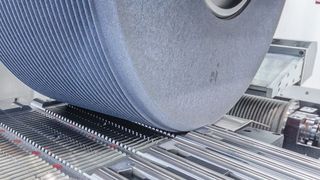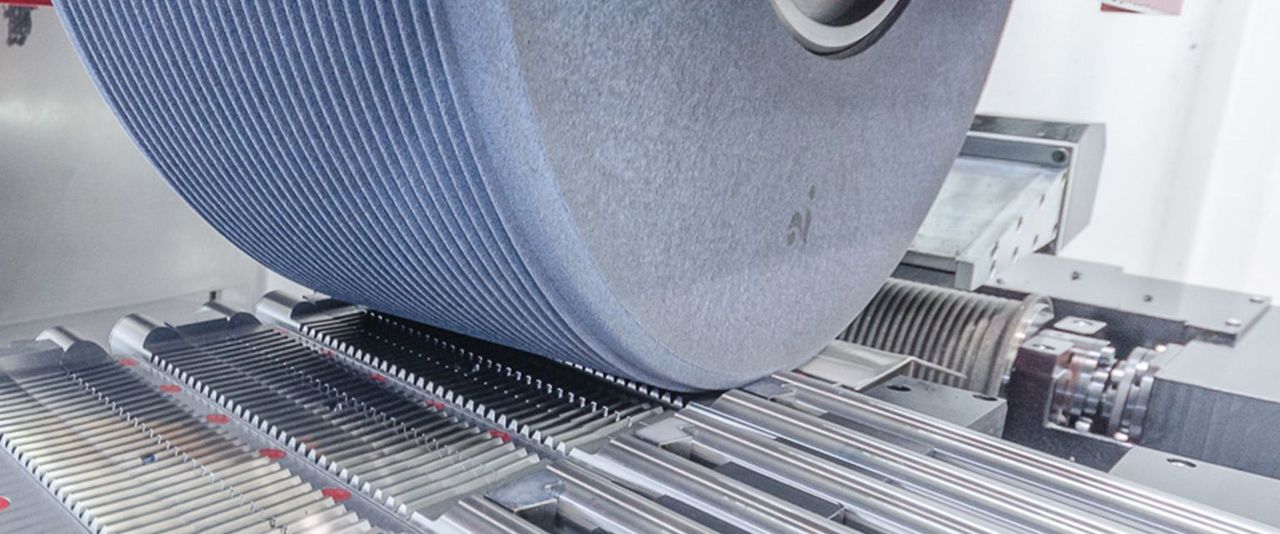Creep Feed Grinding Might Be the Solution to Your Production Challenge
Creep Feed Grinding Might Be the Solution to Your Production Challenge
Many industries are following the lead of aerospace and demanding the use of highly challenging materials to produce stronger, high-value parts with tighter tolerances and complex geometries. Harder materials such as superalloys and carbide-based ceramic composites result in more durable parts, but they are harder to machine.
Milling, broaching and hard turning may no longer be the solution for removing material from challenging materials. With advances in wheel technology, grinding — long viewed as a finishing tool — may be the solution.
When implemented with the right equipment and knowledge, creep feed grinding and its high material removal rate (MRR) can often streamline processes and produce higher quality parts. In some cases, creep feed grinding is as much as 40 percent faster than alternative processes while providing improved surface finish quality.
While creep feed grinding often is superior to other applications in terms of MRR, continuous dress creep feed (CDCF), which maintains wheel sharpness through the long, productive passes, often is even more efficient. CDCF’s greatest savings may be in undoing the traditional elongated process of milling, heat treatment, deburring and finishing by combining those applications into one operation.
How Demand for Harder Materials Led to a Comeback for Grinding
About 15 years ago, there was some thought that grinding was on the decline for some industries. Grinding historically was perceived as an expensive and complex finishing process that produced a lot of particulates. Machine tool makers had developed turning tools that could better process hard materials and could rely on milling for others.
Hard turning could produce parts faster and cheaper, but the part might not last, which ultimately impacted uptime for customers. Since then, first with aerospace and then with the automotive and medical device sectors, manufacturers have demanded even stronger parts with tighter tolerances. Greater use of these hard materials also presented significant challenges for milling.
The grinding process produces surface integrity that does not sacrifice the integrity of the part. So as complex materials have been introduced and adopted, machine tool makers have worked on improving grains and bonds in grinding wheels. Tougher materials called for tougher wheels.
The result of these new grinding wheels is the ability to make a deeper cut in the harder materials, which significantly increased the MRR while still producing high-performing operations.
The Benefits of Creep Feed Grinding Over Other Applications
The MRR is so significantly higher with new grinding wheel technology that even at a slower feed rate, the long productive passes will shorten cycle time. Among the benefits of creep feed grinding:
- Fewer passes also means less time lost to machine reverses and stops and starts. Several factors are contributing to productivity increases.
- The shorter cycle time also means reduced machine wear and longer wheel life.
- The low feed rate offers more control, which allows for finer tolerance and more complex geometric forms.
- With CDCF, the wheel remains sharp. It’s a perfect cutting tool.
- The heavier grinding depth and slower traverse rate cannot be matched by milling for harder materials.
The challenge for some manufacturers is that creep feed grinding operations require an investment in rigid and robust machines to produce the higher grinding forces. The ROI is realized by several factors:
- Lower price per part.
- Faster cycle times.
- Lower overall tooling costs.
- Higher quality.
Creep feed grinding also is a space-efficient alternative to broaching. Fir-tree forms common in aerospace often require a broaching setup that could be 30 to 40 feet in length. Creep feed grinding allows the same machining to be performed within a typical-size machine tool.
Why Continuous Dressing Creep Feed Works So Well for Hard Materials
The continuous dressing of grinding wheels keeps temperatures in check and the wheel sharp. Because the wheel is always sharp, lengthy cuts are possible, which drives efficiency. Plus, this consistent wheel performance results in lower average grinding forces and leads to even more efficient abrasive use, shorter cycle times and increased production rates.
CDCF oftens allows the reordering or combining of processes. What previously was done by milling, outsourcing for heat treatment, and finishing often can now be done with CDCF in one clamping or setup. The savings are significant.
One UNITED GRINDING customer made a medical device implant that took about an hour per part with 20 percent of material being scrapped. The manufacturer introduced CDCF to their shop and no longer had to stop production for dressing, instead dressing and grinding simultaneously while being more aggressive with cuts. They were able to maintain the profile shape and the size of the part and reduce the cycle time to about 10 minutes. They have significantly also reduced downtime and scrap while producing a higher-quality part.
The Latest in Grinding Wheel Technology: Intermittent Dressing
Newer grinding wheels with ceramic grit remain sharp for a longer period of time.
These advances enable:
- Intermittent dressing, which can extend the life of the wheel and drive efficiency.
- Longer machine life.
- The wheel to be used on less expensive CNC machines.
In fact, engineers from a leading maker of grinding wheels, Norton, have used superabrasive wheels for creep feed without any dressing. The superabrasive wheels are designed to be used without dressing, which further lowers barriers for entry into creep feed grinding.
Find the Right Partner for Your Pursuit of Creep Feed Grinding
Let UNITED GRINDING get you started with machine models powerful enough for this efficiency-boosting, part-processing approach. Connect with UNITED GRINDING to see if the latest grinding wheel technology supporting creep feed grinding or CDCF can be put to use at your shop.









